- What is fluorescence?
- What causes fluorescence?
- Does fluorescence cause a hazy, oily, or milky appearance?
- Why do jewelers insist so many strong fluorescent diamonds are hazy or milky?
- Does strong fluorescence cause overgrading of color?
- How does fluorescence affect diamond price/value?
What is fluorescence?
When exposed to invisible ultraviolet (UV) radiation, some diamonds emit visible light, which is termed fluorescence.
Moses, T. M., et al. “A contribution to understanding the effect of blue fluorescence on the appearance of diamonds. G&G, Vol. 33, No. 4.” (1997): 244-259.
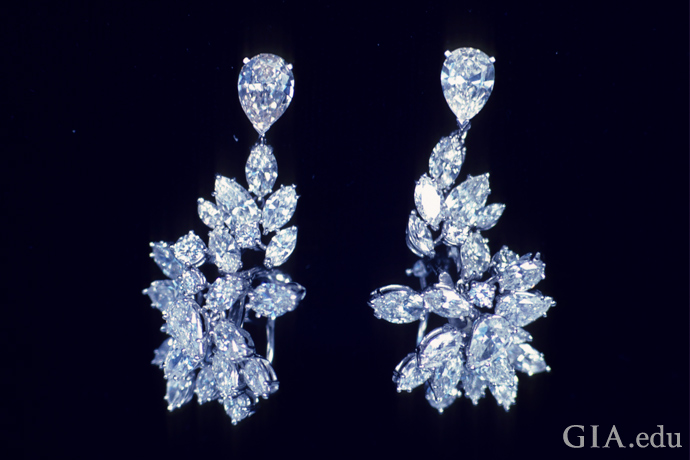
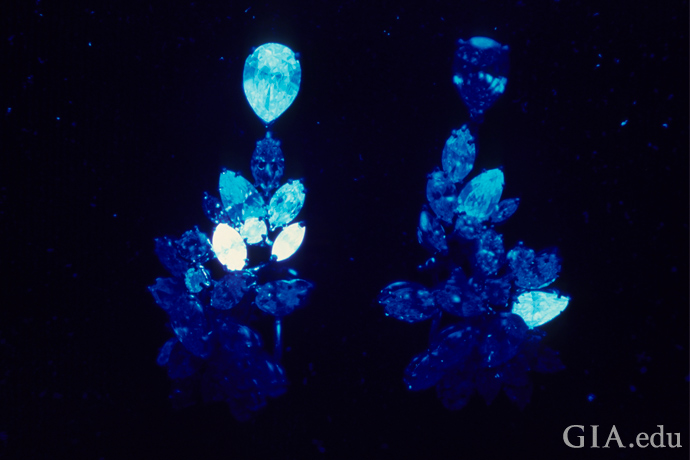
What causes fluorescence?
GIA’s Optical Defects in Diamond: A Quick Reference Chart provides a brief summary of the various causes of fluorescence in diamonds. The N3 optical defect (a nitrogen impurity) causes the blue fluorescence most commonly seen in natural diamonds.
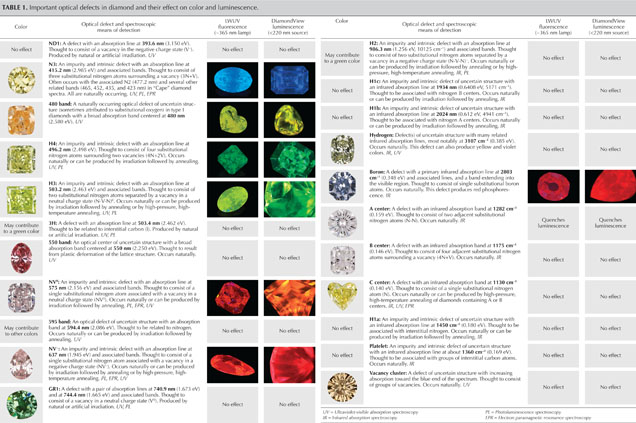
Shigley, James E., and Christopher M. Breeding. “Optical defects in diamond: A quick reference chart.” Gems & Gemology 49.2 (2013): 107-111.
Does fluorescence cause a hazy, oily, or milky appearance?
According to GIA and AGS, strong fluorescent diamonds with a hazy/oily/milky appearance are extremely rare.
Diamonds with extremely strong blue fluorescence and a distinctive oily or hazy appearance, often referred to as “overblues,” are also a concern to the industry. In our experience, however, they are even rarer than diamonds with yellow fluorescence.
As noted above, we did not include those diamonds with extremely strong blue fluorescence and a hazy appearance (“overblues”—see, e.g., figure 4), because we could not obtain sufficient numbers of such stones.
The results of this study indicate that there is a perceptible relationship between blue fluorescence and color appearance, which depends on viewing position. On average, strongly fluorescent diamonds have a better color appearance table-up, and this effect is most noticeable at lower color grades. Most observers did not detect any differences in transparency among diamonds in a given color set. Of those who did see a difference under fluorescent lighting, it was only apparent in the table-down position. These results challenge the notion that strongly fluorescent diamonds typically have a hazy appearance.
Moses, T. M., et al. “A contribution to understanding the effect of blue fluorescence on the appearance of diamonds. G&G, Vol. 33, No. 4.” (1997): 244-259.
In rare cases, some diamonds with extremely strong fluorescence may appear hazy or oily; fewer than 0.2% of the fluorescent diamonds submitted to GIA exhibit this effect.
https://4cs.gia.edu/en-us/blog/understanding-diamond-fluorescence/
We’re focusing on the impact of fluorescence on the transparency of the diamond. We’re looking at the possibility of fluorescence showing this milkiness versus non-milkiness. And what’s interesting about this is that the more that we look at this particular phenomenon it’s become very difficult to actually find samples of diamonds that really exhibit this phenomenon. So far in the research, what we’ve found is that this so-called milkiness effect is very rare and it’s relatively difficult to actually find diamonds that exhibit that strongly.
Jason Quick, Executive Director of AGS Laboratories https://www.youtube.com/watch?v=qFjA2AxWcZE&t=822s
Why do jewelers insist so many strong fluorescent diamonds are hazy or milky?
Jewelers may be conflating extremely rare hazy strong fluorescence with more common whitish internal graining (which may be exacerbated when a diamond fluoresces).
Dislocations in the diamond lattice are the main cause of banded or tatami graining. Lattice distortion affects many physical properties, such as refractive index. Instead of light following its typical path through the diamond, in the distorted region it is refracted or diffused due to the difference in R. I. between that region and the surrounding lattice.
In extreme cases, the graining is so intense and widespread that the observer has the sensation of looking through a screen (i.e., the “crisp” appearance is diminished.)
King, J. M., Moses, T. M., & Wang, W. (2006). The impact of internal whitish and reflective graining on the clarity grading of D-to-Z color diamonds at the GIA laboratory. Gems and Gemology, 42(4), 206.

When a diamond is strongly fluorescent and also contains light-scattering structural defects, these producers of contrast loss seemingly combine to cause a noticeably milky or hazy appearance.
Luo, Y., Nelson, D., Ardon, T., & Breeding, C. M. (2021). MEASUREMENT AND CHARACTERIZATION OF THE EFFECTS OF BLUE FLUORESCENCE ON DIAMOND APPEARANCE. Gems & Gemology, 57(2).
It is common to find diamonds that show this fuzzy strain (at all fluorescence levels, not just strong), even in the highest clarity grades. The diamond on the left shows fuzzy strain, indicated by the faint lines seen on the facets (also visible as you rotate the diamond in superzoom). The diamond on the right does not. What jewelers perceive as hazy strong fluorescence may be conflated with poor diamond crystal quality.
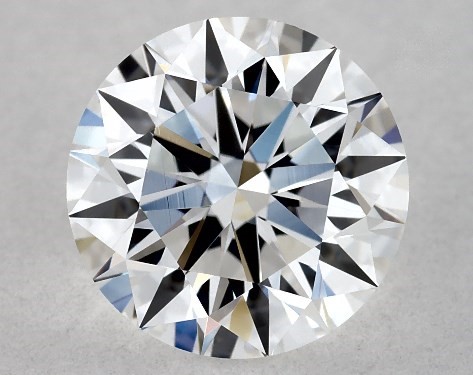
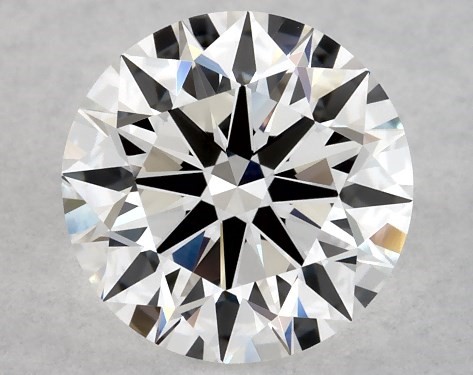
Does strong fluorescence cause overgrading of color?
Yes, studies suggest that strong fluorescence can cause overgrading of color. Light is an additive color system in which blue + yellow = white.
For over a hundred years, it has been recognized that the light yellowish tints in a type 1a diamond combine with the various amounts of blue fluorescence, stimulated by daylight and other illumination containing ultraviolet (UV) energy, to give blue-fluorescent diamonds a whiter perceived colour than the colour seen in lighting where fluorescence is not stimulated to a noticeable degree.
Cowing, Michael D. “The over-grading of blue-fluorescent diamonds: the problem, the proof and the solutions.” Journal of Gemmology 32.1 (2010): 38.
The fluorescent lamps used in the GIA DiamondDock emit UV light which activates blue fluorescence. In the figure below, diamond samples 1-5 exhibit very strong blue fluorescence, 6-10 exhibit strong blue fluorescence, 11-15 exhibit medium fluorescence, 16-19 exhibit faint fluorescence, and 20-25 exhibit no fluorescence.
In the GIA DiamondDock, strong blue fluorescent diamonds were graded as 1-2 color grades whiter than when they were graded in the absence of UV light. Medium fluorescent diamonds were observed to be 0-1 color grades whiter. No effect was observed for none and faint fluorescent diamonds. These results are the reason why we show only medium and below by default in our price curves.
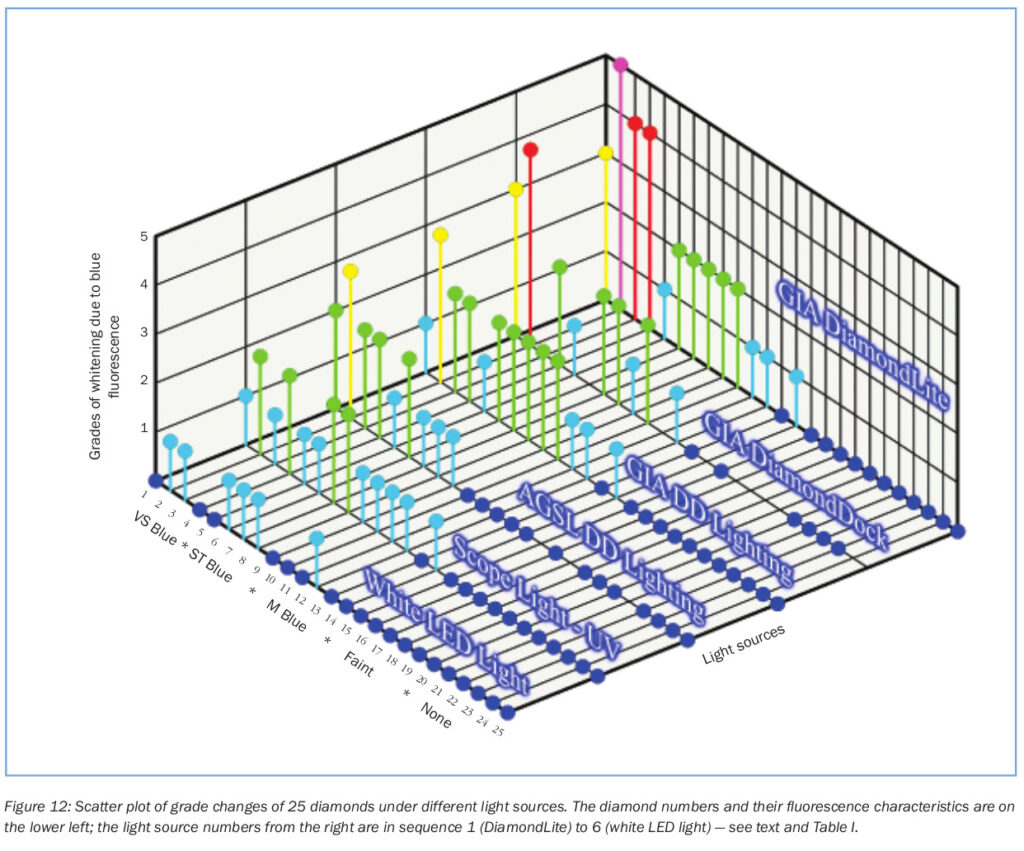
More recently, HRD Antwerp conducted a study entitled “The Effect of Blue Fluorescence on the Colour Appearance of Round-Brilliant-Cut Diamonds.” Although their study design does not directly answer the question of whether strong fluorescent diamonds are overgraded for color (they have a more contrived setup that uses calibrated UV LEDs rather than the UV emitted from the actual grading lamps themselves, at a farther distance than diamonds are graded in the GIA DiamondDock), their results are not inconsistent with potential overgrading. In the figure below, strong fluorescent diamonds in the indoor setting (that mimics next to an office window facing north-east; protected from direct sunlight by high-rise buildings) were observed to be roughly one-color grade higher than when they were graded by HRD.
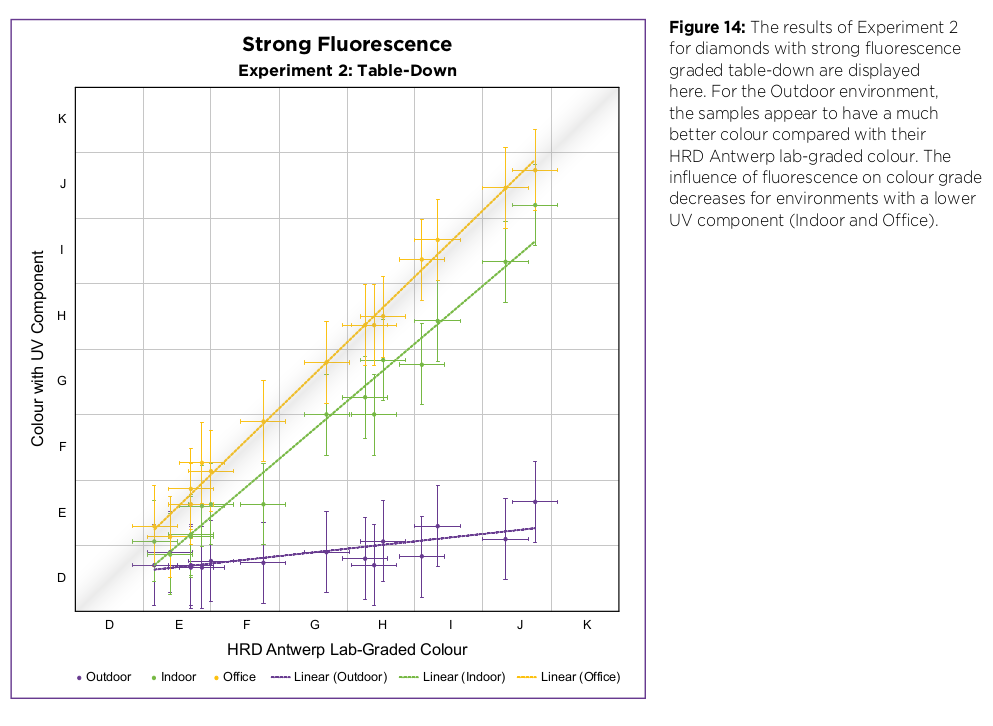
How does fluorescence affect diamond price/value?
Stronger fluorescent diamonds tend to be cheaper than weaker fluorescent diamonds of the same color grade.
Since the late 1970s and early 80s, however, fluorescence has been perceived as an undesirable characteristic. This has resulted in price discounts as high as 30% for strongly fluorescent diamonds. The price differentiation is linked to a number of reasons, including concerns about over-grading of colour, as well as reduced transparency (perceived as an oily appearance).
Bouman, Marleen, et al. “The Effect of Blue Fluorescence on the Colour Appearance of Round-Brilliant-Cut Diamonds.” Journal of Gemmology 36.4 (2018).
Consumer concerns about reduced transparency seem overblown given how rare hazy fluorescent diamonds are according to GIA and AGS; however, they have a real effect on price by reducing demand for fluorescent diamonds. Color over-grading appears to be a valid concern and can in-part explain why strong fluorescent diamonds are cheaper than non-fluorescent diamonds.
How is this diamond, and how are other strongly fluorescent diamonds, to be valued? Based on the higher color grade, with a large deduction for the strong blue fluorescence? Or based on the lower color grade, with a large premium for the strong blue fluorescence? Personally I prefer, and professionally I practice, the latter.
Tashey, T., 2009. Letters. More on D-Z diamond color grading. Gems & Gemology, 45(2) 51–2
An indication of the extent to which fluorescence influences market value is found in the Rapaport Diamond Report weekly price guide. In the November 7, 1997, Report, for example, some higher-color (D-H) diamonds with very strong fluorescence were listed for up to 15% less than comparable non-fluorescent stones. From the spring of 1993 until the present time, the Report has stated that “the impact of blue fluorescence on price depends on its noticeability.” Although the fluorescence description (which is based on observations made under a long-wave UV lamp) can be read from a laboratory grading report, “noticeability” refers to the direct observation of the diamond under the lighting conditions of a normal trading environment. In that same issue of the Report, lower-color (I–N) diamonds with very strong fluorescence carried a premium of up to 4% over similar non-fluorescing stones. This may be due to the continuing perception of many in the trade that blue fluorescence acts to mask or offset the faint to very light yellow body color of some gem diamonds.
Moses, T. M., et al. “A contribution to understanding the effect of blue fluorescence on the appearance of diamonds. G&G, Vol. 33, No. 4.” (1997): 244-259.
For example, a strong fluorescent H might be the equivalent of a non-fluorescent I. In practice, the lower non-UV-biased color grade reduces the price more than any potential price increase from fluorescence (as evidenced by Tashey’s practice and GIA’s Rappaport price observations). In this example, you wouldn’t be getting a deal on the H, you’d be paying the appropriate price for the comparable non-fluorescent I that it actually is under non-UV conditions.
If a fluorescent diamond isn’t hazy and isn’t over-graded for color, it may be possible to take advantage of the discount commonly found on fluorescent diamonds. However, that’s a lot to consider, so it’s generally safer to avoid strong fluorescence as a novice.